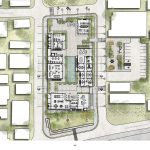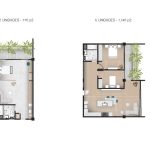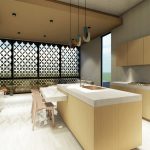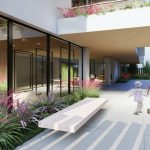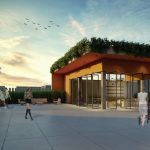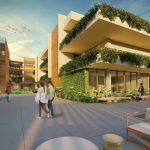An architecture against violence: A space of healing and rehabilitation for women
” Social models developed under male chauvinist views, classifying spaces by gender. This has been one of the many reasons why spaces could foster violence. The man maintains control of the spaces, preventing the collapse of the classification of areas by gender and possibly give way to inclusive spaces”. – Paola Isabel Pérez Miranda, 2020.
Designer: Paola Isabel Pérez Miranda
Thesis Committee Director (s): Arch. José Coleman-Davis & Prof. Omayra Rivera Crespo
Thesis Committee Consultant (s): Prof. Liliana Ramos Collado
Location: San Juan, Puerto Rico
Completion Date: May 2020
TOS [er]: Sofía M. Acosta Montalvo
Posted: May 2022
About An architecture against violence:
The research focuses on the need to plan shelters for victims of domestic violence in Puerto Rico, specifically, facilities that are designed in advance to serve this population. The motivations for mistreatment are often comprehensive, however, this study focuses on the effect that architecture has on domestic coexistence. Pérez-Miranda’s hypothesis is that features of the predominant dwelling of the 20th century could propagate inequity. As part of the research, shelters in Puerto Rico that provide outpatient services and lodging to female victims were analyzed. Considering that the spatial quality and context of the space of protection/shelter is essential for the recovery of the participants. For Perez-Miranda, architecture plays a key role in giving the victims a sense of well-being.
[Keywords: shelters, domestic violence, female victims, architecture, domestic coexistence, recovery, protection space]
Project description:
The project, Casa Albergue, is an emergency shelter that provides services and accommodation for women alone, or with children, that have been victims of physical or emotional domestic violence. These facilities provide the participants with security and with emotional support. On leaving the shelter, the participants are provided with legal and psychological counseling, as well as housing. Casa Albergue is aimed at empowering women to gain control of their lives through short and long term goals and to develop a sense of independence and self-sufficiency.
Objectives:
This research and design address the needs of the community of women who have suffered domestic violence and how they can be empowered while staying in this temporary shelter.
- Study and understand how a space can be more inclusive, promoting equity
- Create inclusive and safe spaces for its users
- Plan spaces that house mothers and their children and/or women alone, that also promote their physical and emotional well-being
- Design spaces that inspire a positive impact on its users
- Analyze examples/ precedents of existing shelters to identify their challenges as well their benefits
Methodology:
Pérez Miranda studies Adolf Loos’ approach to domestic space to understand how the history of architectural e spaces may have promoted domestic violence. Loos’s house designs intended for women to stay inside hidden, while men could wander freely in the exteriors and more public spaces. Nonetheless, Leslie Kanes Weisman (architect, educator, and community activist)argued that the traditional home that alienates women from the exteriors had to be deconstructed for women to be able to revolt against patriarchal injustice they faced at home. This would enable women to become a part of the public space with the same right as men, promoting equity. Some primary goals of the research are:
- Provide solutions to create an inclusive and safe space for women victims of domestic abuse, as well as for their children.
- Visit shelters for abused women in Puerto Rico.
- Conduct studies to understand the needs of residents and the employees.
- Define criteria necessary for women’s self-sufficiency within an urban area and design elements that improve the emotional health of the user.
- Analyze the spatial qualities of the shelters in Puerto Rico to define criteria necessary for the development of the architectural design that will be of benefit to future shelters on the island and to the architectural proposal in this research.
- Propose a facility that provides shelter, transitional housing, services, and relief to women who face domestic violence.
Design Strategies:
The emergency shelter proposed in this research provides services and accommodation for single women or women with dependents who have suffered some type of physical or emotional domestic violence. These facilities must provide security, emotional support, registration for the education of children, personal hygiene products, clothing, legal and psychological counseling, and housing after leaving the shelter to help women develop their independence The site must be in a private area to keep the shelter safe from potential assailants. Located in Comunidad Machucal, the site benefits from various factors. This community is in a private area near Calle Loíza and has multiple outdoor playgrounds. An existing bridge to the South of the site will be worked on to maintain the program’s intimacy. Key design qualities:
- Lighting, gardens, colors, furniture, and a feeling of amplitude are used to encourage the well-being of the women in the shelter.
- A courtyard strategically located in the center of the project to allow spaces of visual connection with the context.
- Four volumes with particular spatial characteristics related to the proposed program and its users.
- A system of control access points maintains the boundaries of the building as barriers to the outside.
- The relationship between public and private space is essential for the physical and emotional improvement of the participants.
- Coexistence is encouraged through spatial design and organization.
Project Program:
The proposed program represents the needs of the participants and employees of the hostels studied in the field work. It is divided into five zones surrounding the interior patio: administrative services of the shelter, shelter services, rooms program, and temporary housing. The program promotes a sense of community and vision between spaces creating a connection between inside and outside.
- Shelter Administrative Services
- Reception
- Babysitting + Playground
- Administration Offices
- Service Offices
- Employees Lounge + Kitchen
- Nursing Room
- Conference Room
- Shelter Services
- Participants Multipurpose Room
- Library
- Gym
- Beauty Salon
- Kitchen
- Dining Room
- Living Room
- Shelter Rooms Program
- Participating Rooms
- Facilitating Office
- Laundry
- Temporary Housing
- Reception
- Housing Units
TOS [er] Reaction:
The relationship between domestic abuse and architecture is of great relevance. Typically, when people think about a “house” or “home,” what first comes to mind is a safe place. A house is usually thought of as a place where the users are protected from potential exterior dangers. As a future architect, I have grown to appreciate the immense importance of how the design of a house will affect the quality of life of the women living in it. I am now more aware of how architecture can facilitate domestic violence if not designed properly. Pérez Miranda thesis goal is to offer, “…an architecture against violence.” She offers an example for future generations of how to provide a shelter for women victims alone or with their children as a solution to this alarming situation in Puerto Rico.


